Search the Blog
Latest Comments
Beatrix
Experiment!
23. April 2024
The video doesn´t work (at least for me). If I click on "activate" or the play-button it just disapp...
Katrin
Spinning Speed Ponderings, Part I.
15. April 2024
As far as I know, some fabrics do get washed before they are sold, and some might not be. But I can'...
Kareina
Spinning Speed Ponderings, Part I.
15. April 2024
I have seen you say few times that "no textile ever is finished before it's been wet and dried again...
Katrin
How on earth did they do it?
27. März 2024
Ah, that's good to know! I might have a look around just out of curiosity.
I've since learned that w...
Heather Athebyne
How on earth did they do it?
25. März 2024
...though not entirely easy. I've been able to get my hands on a few strands over the years for Geor...
Very Old Knitting, Part 3.
As Harma pointed out yesterday in the comments, there' s an issue with crossed stitches in the knitting method I've shown. Well. Let' s tackle this issue right away, shall we?
I took very good care to follow the instructions exactly, including the direction the yarn wraps around the needle. Which, indeed, results in twisted stitches (the legs crossing) every other row... why? Because of the stitch alignment. Remember that I mentioned how the stitches lie on the needle in that method, partly with the right leg in front and partly with the right leg in the back?
Having twisted stitches every other row points to there being an issue in only one of the rows - either when working on to the left needle, or when working on to the right needle. So let's make things easier to sort it out by restricting ourselves to one direction only. This is done by working in the round (all the extant pieces I know of, by the way, were worked in the round). Or, if you are a lazy person like me who just wants to do a few test stitches and not fiddle too much, on a pair of double-pointed needles. (The trick is to just move the knitting over to the other end of the needle, let the yarn go right across the back of the fabric, and knit the next row in the one and only working direction.)
I'll be sticking with the first row for now... here we go:
[caption id="attachment_2025" align="alignnone" width="300"]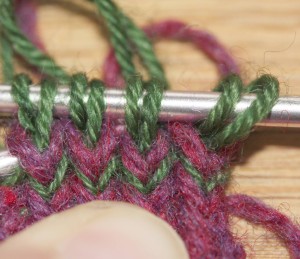 After a few rows of working on to the right needle.
After a few rows of working on to the right needle.
This is what it looks like after a few rows, always working from the left needle on to the right needle (following the instructions). All stitches are aligned in the same way: with the right leg in front of the needle, as customary in modern Western European knitting. And you can hopefully see that all the stitches are twisted - the left leg crosses over the right leg in every stitch. So this is the row, obviously, where something happens that should not happen.
Where does the twisting occur? Here' s what happens:
[caption id="attachment_1935" align="alignnone" width="300"]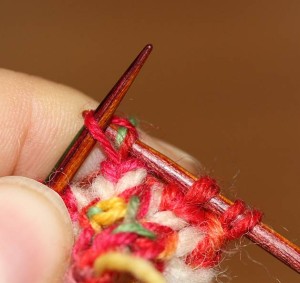 ... and pull through.
... and pull through.
The right stitch, with its right leg in front of the needle, is drawn over the two newer stitches. The right leg is thus drawn to the left of the two stitches - resulting in a twisted stitch.
Sometimes it can be hard to see whether stitches are twisted or not - if in doubt (and the fabric can take it, obviously that' s not possible with archaeological knitting) just stretch the thing out.
If the stitches are untwisted, it opens up completely:
[caption id="attachment_2029" align="alignnone" width="300"]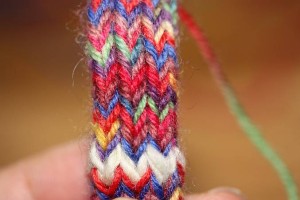 Knitting from the dolly, in its normal state...
Knitting from the dolly, in its normal state...
[caption id="attachment_2030" align="alignnone" width="300"]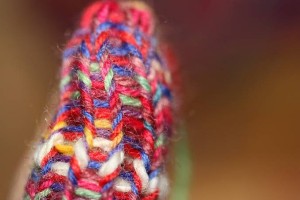 ... and stretched horizontally. Stitches and ladders between stitches both open up.
... and stretched horizontally. Stitches and ladders between stitches both open up.
When you stretch out the knitting with twisted stitches, the ladders between the stitches open up, but the stitches themselves are pulled tighter, forming firm little columns between the ladders:
[caption id="attachment_2031" align="alignnone" width="300"]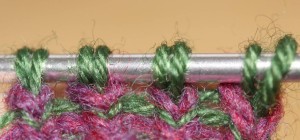 The knitting stretched out - you can see that the stitches are pulled tighter together.
The knitting stretched out - you can see that the stitches are pulled tighter together.
So. Our twisty issue lies with the stitches in the row working onto the right needle, and it' s related to the alignment of the stitch on the needle when pulling the stitch over. There you go. Next time, we'll take a look at the other row...
I took very good care to follow the instructions exactly, including the direction the yarn wraps around the needle. Which, indeed, results in twisted stitches (the legs crossing) every other row... why? Because of the stitch alignment. Remember that I mentioned how the stitches lie on the needle in that method, partly with the right leg in front and partly with the right leg in the back?
Having twisted stitches every other row points to there being an issue in only one of the rows - either when working on to the left needle, or when working on to the right needle. So let's make things easier to sort it out by restricting ourselves to one direction only. This is done by working in the round (all the extant pieces I know of, by the way, were worked in the round). Or, if you are a lazy person like me who just wants to do a few test stitches and not fiddle too much, on a pair of double-pointed needles. (The trick is to just move the knitting over to the other end of the needle, let the yarn go right across the back of the fabric, and knit the next row in the one and only working direction.)
I'll be sticking with the first row for now... here we go:
[caption id="attachment_2025" align="alignnone" width="300"]
 After a few rows of working on to the right needle.
After a few rows of working on to the right needle.This is what it looks like after a few rows, always working from the left needle on to the right needle (following the instructions). All stitches are aligned in the same way: with the right leg in front of the needle, as customary in modern Western European knitting. And you can hopefully see that all the stitches are twisted - the left leg crosses over the right leg in every stitch. So this is the row, obviously, where something happens that should not happen.
Where does the twisting occur? Here' s what happens:
[caption id="attachment_1935" align="alignnone" width="300"]
 ... and pull through.
... and pull through.The right stitch, with its right leg in front of the needle, is drawn over the two newer stitches. The right leg is thus drawn to the left of the two stitches - resulting in a twisted stitch.
Sometimes it can be hard to see whether stitches are twisted or not - if in doubt (and the fabric can take it, obviously that' s not possible with archaeological knitting) just stretch the thing out.
If the stitches are untwisted, it opens up completely:
[caption id="attachment_2029" align="alignnone" width="300"]
 Knitting from the dolly, in its normal state...
Knitting from the dolly, in its normal state...[caption id="attachment_2030" align="alignnone" width="300"]
 ... and stretched horizontally. Stitches and ladders between stitches both open up.
... and stretched horizontally. Stitches and ladders between stitches both open up.When you stretch out the knitting with twisted stitches, the ladders between the stitches open up, but the stitches themselves are pulled tighter, forming firm little columns between the ladders:
[caption id="attachment_2031" align="alignnone" width="300"]
 The knitting stretched out - you can see that the stitches are pulled tighter together.
The knitting stretched out - you can see that the stitches are pulled tighter together. So. Our twisty issue lies with the stitches in the row working onto the right needle, and it' s related to the alignment of the stitch on the needle when pulling the stitch over. There you go. Next time, we'll take a look at the other row...
Comments
No comments made yet. Be the first to submit a comment



